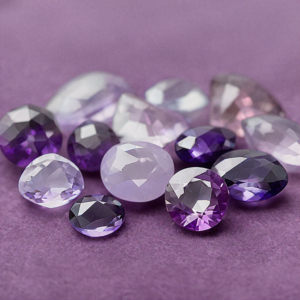PURPLE GEMSTONES

Purple gemstones are a diverse and captivating group, encompassing a range of properties and types. They are often associated with luxury, creativity, and spiritual growth. These gemstones can be found in various shades, from light lavender to deep, rich purples, and may exhibit layers of color variation within a single specimen.
Some popular types of purple gemstones include amethyst, a violet variety of quartz, and spinel, which owes its purple color to a combination of iron and chromium traces. Alexandrite, one of the most expensive gemstones, is known for its ability to change color depending on the light, appearing deep purple in incandescent light and teal in sunlight. Other types of purple gemstones include tanzanite, a blue and violet variety of zoisite, iolite, which occurs in lovely blue-purple shades, and purple sapphire, valued for its spiritual and medicinal qualities.
Additionally, there are lesser-known purple gemstones like sugilite, a rare and translucent gemstone with a Mohs hardness of 5.5 to 6.5, and purple chalcedony, which occurs in different shades of purple due to impurities present in the stone. Each of these gemstones has its unique properties, characteristics, and meanings, making them highly sought after for their beauty and significance.
LIST OF PURPLE STONES
1. PURPLE AMETHYST
The purple amethyst is a type of quartz crystal that is characterized by its distinctive purple color, which can range in hue from a light lavender or pale violet to a deep purple. It is a popular gemstone that has been used in personal adornment for over 2000 years and is often associated with tranquility, calmness, and spiritual connection. Amethyst is the birthstone of February and is also an important New Age gem. It is known for its ability to produce faceted stones, cabochons, beads, and other items for jewelry and ornamental use. The name “amethyst” comes from the Greek word “amethystos,” which means “not drunken,” as it was believed in antiquity to ward off drunkenness. The color of amethyst is due to gamma irradiation and trace amounts of iron.